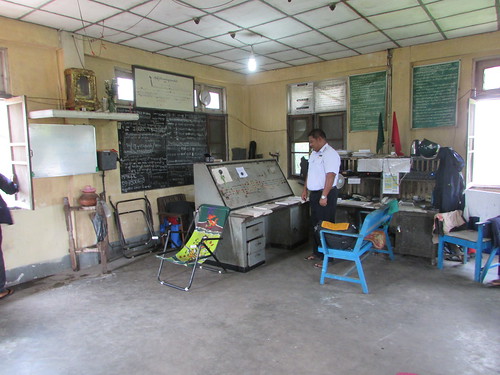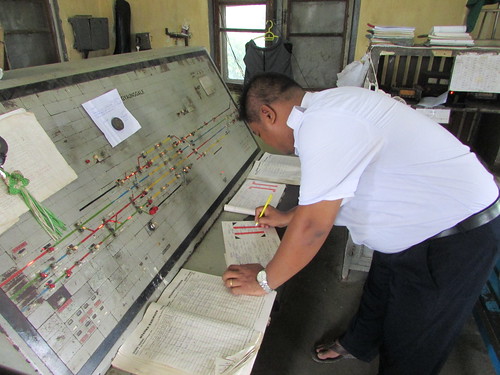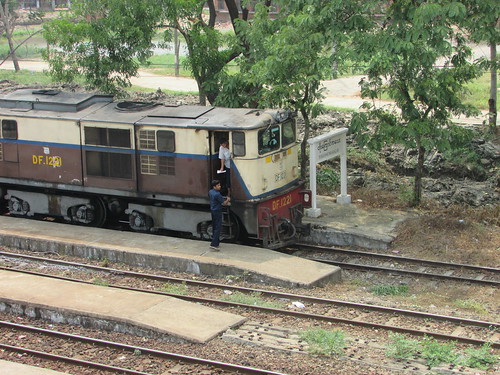In the post Return to Burma, I mentioned a visit to Togyaunggalay (Romanisation of Myanmar words can be a bit variable and there are various English spellings of the placename). My friend Doctor Hla Tun had arranged a visit to the elderly power signal box at Togyaunggalay station on the day I arrived in Myanmar. Earlier that day we'd visited the recently-commissioned Railway Operation Control Center in Yangon (described in a post here) after which the Doctor drove us through Yangon's heavy traffic to the junction station at Togyaunggalay.
The railway network around Yangon is shown below. Togyaunggalay station is situated on the double track main line from Yangon through Bago to Mandalay. A junction just north of the station connects the single line serving Dagon University. A junction south of the station leads to the single line to Thilawa.
In 2018, after visiting the railway at Bago, I'd travelled through Togyaunggalay by train (there's a description of that trip here) so I was pleased to have the opportunity to confirm the signalling arrangements.
My pictures
All my railway pictures around Yangon during my visit to Myanmar in 2019 are in the album below. Pictures may be viewed in various sizes or downloaded for non-commercial use.
In 2018, after visiting the railway at Bago, I'd travelled through Togyaunggalay by train (there's a description of that trip here) so I was pleased to have the opportunity to confirm the signalling arrangements.
On our arrival in 2019, we reported to the Station Master and were conducted along the main platform to the concrete signal box and climbed the steps to the operating floor. The loud noise emanating from the ground floor equipment room indicated that the incoming overhead 3-phase electricity supply was absent and that the system was being run by the standby generator. The first floor equipment room was locked, so I couldn't study the relay interlocking equipment but continued to the second floor where we were welcomed by the signalman.
Togyaunggalay signal box on 9th May 2018: Note radio antenna on left and incoming overhead 3-phase electricity supply terminated on frame on the right (Bago - Yangon by train).
The railway signalling console was of the 'NX' pattern (there's a very brief explanation of this type of control in the section 'NX' pushbuttons of the post here) and used 'Mosaic' construction.The signalling console looked rather small, situated near one corner of the room. A desk just to the right was furnished with red and green flags, a number of telephones, two VHF radiotelephones for train control and a power amplifier and microphone for making announcements to waiting passengers. The windows overlooking the tracks behind the signalling console had been largely blocked by a large blackboard covered in what appeared to be useful telephone numbers. Above the blackboard was the usual framed drawing of the track layout and a clock. To the left, on a small shelf, was the customary Buddhist shrine.
Togyaunggalay: The operating floor of the signal
cabin, showing the Korean 'NX' signalling panel
cabin, showing the Korean 'NX' signalling panel
A Mosaic Diagram, as the name implies, assembles a series of small 'tiles' into a frame. Each 'tile' has part of the signalling diagram on its face, together with the associated control switches and lamp indications. Each 'tile' can be individually removed for maintenance.
I assumed that the siting of the blackboard was at least partly so that the lamp indications on the console were easier to see in bright sunlight, but nonetheless, I found some of them hard to interpret (or missing). They explained that spares, particularly the filament lamps used for indications, had become hard or impossible to source. They'd been forced to modify the circuits (in places using two lamps in series) but admitted that the result was not altogether satisfactory. Despite this, the signalman was carrying out his crucial tasks with the usual studied calm typical of signalmen everywhere.
The flat desk area in front of the inclined control panel held two train register books and two books of paper Line Clear forms.
The Train Register Books serve a similar function to those used in the United Kingdom (described in a post here) although in Myanmar movements are separated into two books, one for 'Up' trains, one for 'Down'. Because of the importance of these logbooks, pages are individually numbered.
The British introduced railways into Burma (as Myanmar was then called) so signalling originally followed British practice, with reliance on telegraphy, telephony and special signalling equipment (like electric tablet systems for single lines). This relied on an open wire system using telegraph poles supporting cross-arms carrying porcelain insulators to which copper wires were attached. Remnants of this system can be seen throughout the country (invariably using an old length of rail as the 'pole') but, as far as I can determine, they have all fallen into disuse. Voice communication across the railway now uses VHF radiotelephones, allowing signalmen or stationmasters to authorise train movements from one 'block station' to the next. The permission is given to drivers in the form of a 'Paper Line Clear Form', shown in the picture below. Because of the vital nature of these forms, they are individually numbered, completed with some care and authorised with a rubber stamp.
The pictures below show a local train from Yangon to Dagon University. In the first picture, the train has just arrived. The freight train seen waiting on the left was unusual in having a number of men travelling in open bogie wagons type SMBV, perched on piles of rock. The Doctor explained that the 'rock' was extremely valuable jade and the men were security.
The second picture shows the signalman's assistant or 'runner' delivering the Paper Line Clear Form to the driver of the passenger train, authorising travel on the branch to Dagon University.
At the end of a fascinating tour, I made sure I checked out the throbbing standby generator on the ground floor - a substantial Daewoo packaged diesel alternator. Its claim to being 'sound proof' was a little undermined by the need to leave all the access doors open to prevent overheating (the outside air temperature was around 40 degrees Celsius that day).
They explained that, even with the access doors open, the water-cooled diesel engine required periodic replenishment of water. Illustrating this point, as we left, a railwayman had just pushed a small platelayer's trolley along the platform line outside to the signal box, loaded with a plastic dustbin and a large plastic tub, both filled with water!
A most interesting day. I'd visited both the Railway Operation Control Center in Yangon and Togyaunggalay power signal box on the day I'd arrived in Myanmar and, later in the trip, I was to tour 'Mandalay Tower', the power signal box controlling Mandalay area.
All my railway pictures around Yangon during my visit to Myanmar in 2019 are in the album below. Pictures may be viewed in various sizes or downloaded for non-commercial use.












